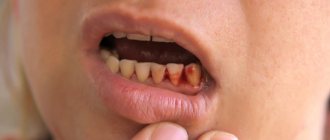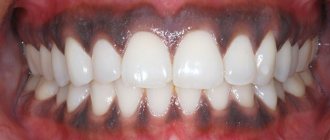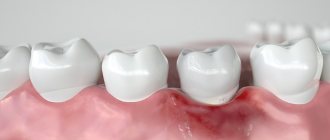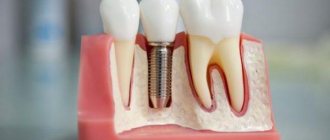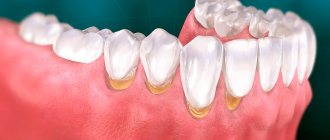In general, the condition of the front teeth greatly affects the aesthetics of your smile. Darkening of the front tooth makes patients want to solve the problem of darkening as quickly as possible - this is a good motivation to visit an endodontist. Especially if you are going to correct your bite using aligners or braces. If a patient’s tooth has darkened, this is a unique and timely motivation to take care of the health of their teeth.
Agree, when even one front tooth has darkened, this is a serious aesthetic problem that affects the eyes of others!
We asked our colleague, chief physician of the German Implantology Center Magomed Dakhkilgov, to talk about the problem of darkened teeth and ways to solve it.
For reference:
Magomed Dakhgilkov - maxillofacial surgeon, implantologist, orthopedist.
The total work experience is more than 20 years, more than 5 thousand dental surgeries have been performed. The doctor who created the German implantology clinics, which today are the best in ratings both in Moscow and in Russia. In his clinics, doctors work exclusively using a microscope and use an analytical approach to dental treatment with maximum preservation of nerve endings. The doctor’s motto is “ The tooth must live
.”
Main reasons
Why can one or more teeth turn blue? There may be several reasons for this; sometimes there is nothing dangerous to health in this process, and sometimes this is a reason to urgently seek advice from a dentist. A change in shade is possible due to poor quality nutrition or adherence to a strict diet. This can also happen if you eat a lot of fresh berries, such as blueberries, blueberries or blackberries.
Newly installed fillings may differ in color from natural tissues. A pulpless, that is, dead tooth can also change its color. This is explained by the fact that when the pulp is removed, nutrients stop flowing to the tissues.
If a seemingly healthy tooth begins to turn blue, this may indicate that there are problems with the root system. This is usually preceded by serious dental diseases. In addition, the cause of blue enamel may lie in the patient’s body; this phenomenon may be caused by the presence of chronic diseases or problems with the digestive system. Another common reason is the use of low-quality water with high levels of iron.
What causes a filling to change color?
Some patients experience changes in the shade of the filling. Blackening of the filling occurs due to various factors:
- Failure to comply with oral hygiene rules.
- Formation of abundant bacterial plaque or tartar.
- Excessive consumption of pigmented foods.
- Deposition of tobacco tar on the enamel due to smoking.
In rare cases, a filled tooth may appear darker after a professional cleaning or whitening procedure. Light-curing filling compounds are selected in a shade to match the color of natural teeth. During the whitening process, the color of the fillings does not change and they appear darker against the background of the rest of the row.
Treatment of blue teeth
If during diagnostics it is determined that the cause of blueness of all teeth is the use of special products, the dentist or hygienist may prescribe a professional cleaning of the oral cavity. Quite often the patient requires enamel polishing; this allows for the best results.
If after such manipulations the blue discoloration does not disappear, you can try other methods.
First of all, the doctor should send the person for an X-ray examination of the jaw, this will make it possible to make a correct diagnosis, as a result of which the treatment will be as effective as possible. It may also be necessary to remove previously installed fillings and caries-infected hard tissues. If necessary, treatment of the annals and root system of the tooth will be prescribed.
There are several methods to restore the original whiteness of your teeth. One of the most common options is the installation of a composite filling, that is, direct artistic restoration of a row. A more expensive procedure is the production of an artificial crown or special onlays - veneers (indirect restoration).
To treat or not?
What to do if a blue tooth appears? Is there any way to treat the symptom? It all depends on what exactly caused this symptom. To start, try simply using a toothbrush and toothpaste. Thoroughly clean the enamel on all sides and rinse your teeth. After this, evaluate their condition. If the enamel has become lighter, then most likely it is due to nutrition. Review your diet. Eat more dairy products and protein-containing meals.
Blue gums
Another common phenomenon, especially in young children, is blue discoloration of the gum tissue. It often occurs during the eruption of the first, baby teeth. During this process, inevitable damage occurs to tissues penetrated by a huge number of blood vessels of different sizes. As a result, blood can enter the soft tissue, leading to the formation of a small hematoma.
That is why, if a baby has a hematoma or bruise in a place where a new tooth is expected to appear soon, there is no cause for concern. However, in all other cases it is recommended to show the child to the dentist. The cause of blueness may be an inflammatory process. It is usually preceded by diseases such as gingivitis or stomatitis.
It is important that such complications usually occur in children with weakened immune systems. Also, the health of teeth and gums is greatly influenced by compliance with the rules of daily care. Due to the abundant accumulation of plaque and stone, most ailments appear; this is especially dangerous at an early age, when the enamel is not yet strong enough.
Prevention of complications after treatment
Regardless of the color of the gums, every person when caring for them must adhere to the following rules:
- brush your teeth every day after breakfast and before bed;
- the brush should be directed from top to bottom on the upper jaw and from bottom to top on the lower jaw;
- the procedure should be completed with circular movements from the molars to the anteriors;
- horizontal movements of the brush can injure the mucous membrane, as can very hard bristles.
Following these recommendations will help keep your gums healthy under any circumstances.
Associated symptoms
Gums can turn blue not only in the youngest patients, but also in adults. As a rule, this pathology is accompanied by many other symptoms. Most often, a person experiences noticeable pain, especially with accidental contact with tissue or with solid food, and the gums may swell and bleed.
If the cause of darkening or the appearance of age spots lies in the inflammatory process, the following symptoms can be diagnosed: severe fever and chills, itching and burning, the appearance of blood or purulent discharge, and others. In this case, immediate treatment is required in a dental clinic; traditional methods will not be effective.
If the cause of darkening of the gum or tooth is the incorrect installation of a prosthesis or crown, the patient may complain of pain even at rest, as well as slight tingling and numbness of the tissue (a sensation similar to what happens after the end of anesthesia).
previous post
How is a general examination at the dentist performed?
next entry
What to do if the fabrics turn blue
Beforehand, if blueness of the mucous membrane in the mouth appears, you should consult a specialist. There may be a serious pathology at work. The doctor will conduct the necessary examination and prescribe the correct treatment. Self-diagnosis, and even more so self-medication, can cause harm and complicate the situation.
If the reason for the change in shade is poor-quality prosthetics on implants, then correction of the system, the method of fixing it on the gum, or a complete replacement of the structure will be necessary. Probably, to quickly restore the natural appearance of the tissues, the use of a special ointment will be prescribed. The doctor will also tell you how to care for the prosthesis.
Blueness of the gingival area due to the inflammatory process is treated conservatively. Typically, a medication course includes:
- taking an antibiotic;
- undergoing physiotherapeutic procedures;
- massage.
Blue discoloration caused by the installation of a dental implant on the first or second day after surgery is considered normal. It is mostly associated with the traumatic nature of the process. The recovery period takes place under conditions of regular antiseptic treatment of the oral cavity, so the symptom goes away after a little time. As for the change in shade due to the titanium rod shining through the mucous membrane, the situation cannot be corrected. This can be avoided in the future by selecting implants made of zirconium. Its shade is more natural.
Opinion of an implant surgeon : “Over many years of practice as an implantologist, I have seen many cases of gingival tissue turning blue after the procedure for introducing titanium structures. At the first stage, this is a normal phenomenon associated with a violation of the integrity of the jaw structures. Usually after a few days the color is restored due to the normalization of blood circulation. You shouldn’t worry too much about this, just follow the recommendations given by a specialist.”
Sometimes the pathology may not be related to dental aspects . Then the doctor conducts an examination to find out its causes. For this purpose, specialists from other fields are involved.
When to see a doctor
There are situations in which it becomes impossible to visit your doctor. In such cases, you should remember about the serious causes of blue gums that require urgent treatment:
- cyanosis does not subside within 4–5 days;
- in addition to changes in gum color, there are signs of local inflammation (hyperemia, swelling of soft tissues, bleeding gums);
- I am concerned about acute pain that is not relieved by painkillers;
- a sharp increase in body temperature to 38–39 degrees;
- deterioration of the general condition of the body, weakness.
Ignoring a dental problem is fraught with the development of serious consequences. Severe complications include: the formation of a benign or malignant tumor, as well as the occurrence of an intraoral cyst.
Symptoms
When the appearance of the gums changes, patients present the following complaints:
- pain when brushing teeth and chewing food;
- itching in the mouth;
- swelling of the periodontal mucosa;
- bleeding gums;
- the presence of abundant dental plaque and mineralized deposits;
Symptoms of cyanosis of the soft tissues of the oral cavity depend on the cause of the disease, as well as the individual characteristics of the body. Eliminating the cause of blue gums is the first stage of treating the disease and alleviating the patient’s condition.
Why do my gums turn blue?
There are many factors that influence periodontal health. The incidence rate depends on both the age of the patient and his dental status.
Causes of blue gums in a child
Blueness of soft tissues in a child’s mouth can occur for the following reasons:
- Eruption of primary and permanent or permanent teeth.
Due to high mechanical pressure on the blood vessels of the periodontium, a blue hematoma occurs.
- Bruises and cuts.
After falls during active games, multiple hematomas occur. Due to mechanical trauma, a blood clot accumulates at the site of the bruise, as a result of which the gums around the tooth become blue.
Why does an adult's gums turn blue?
The causes of blue gums in an adult can be:
- Disorders of the cardiovascular system, endocrine system, and kidney disease.
- Inflammatory diseases of the oral cavity: gingivitis, periodontitis, herpetic and candidal stomatitis, periodontal disease, accompanied by the deposition of bacterial plaque on the surface of the teeth.
- Caries and its maltings, localized in the cervical area of the tooth.
- Errors in orthodontic treatment.
An incorrectly made denture impairs blood flow in the gingival margin, causing the appearance of a blue tumor. In this case, blue discoloration is a consequence of a violation of the trophism of soft tissues in the oral cavity.
- Surgery.
Blue gum most often occurs after tooth extraction. As a rule, tightening of soft tissues is completed by 10 days after extraction.
- Burns from chemical and thermal irritants.
Chemical burns occur due to exposure of the mucous tissue to aggressive substances used in endodontic treatment. Blue injuries from exposure to high temperatures occur at the household level.
The tooth under the filling hurts. What does the treatment method depend on?
When treating secondary dental caries, the dentist must choose the right tactics: either correct the filling, or remove it and refill the cleaned and treated cavity. In some cases, after removing the affected tissue, the cavity turns out to be so large that to restore the dental crown it is necessary to use special inlays or cover the treated tooth with a crown made from an impression.
- There is no need to remove the entire filling if the chewing surface in the area of only one of the walls of the carious cavity has suffered from secondary caries. Necrotic tissue is removed, a cavity is formed and filled with the same filling material. Then the filling is ground and polished.
- If the infection has spread to several sides or around the entire filling, it is removed, the cavity is formed and treated, and the filling is refilled.
Treatment of tooth abscess at SM-Dentistry
The inflammatory process in the dental tissues will not go away on its own, and treatment at home is extremely ineffective and can only lead to the spread of infection. Therefore, we strongly recommend that at the first symptoms of tooth inflammation, you contact the nearest SM-Dentistry clinic. Highly qualified doctors, the latest dental methods and equipment, safe types of anesthesia make it possible to completely solve the problem of purulent inflammation of the tooth in the shortest possible time.
All types of abscesses are successfully treated at SM-Dentistry:
- gingival - with inflammation of the gums;
- periodontal - with a focus between the tooth and gum;
- periapical - affecting the pulp.
The treatment program depends on the extent of the infection, the nature and cause of the disease. Most often, it consists of cleaning the dental canals and pulp from pus, antibacterial therapy and tooth filling. If infection of the soft tissues of the oral cavity occurs, the intervention of a surgeon may be necessary to eliminate the source of infection while preserving the tooth. To make the treatment painless and comfortable for you, SM-Dentistry doctors use local or combined anesthesia with imported drugs.
After treatment, you will receive detailed recommendations on how to care for your teeth for effective healing. Within a day there will be significant relief.
Our specialists will also diagnose and eliminate dental diseases that caused the abscess. If necessary, you can consult doctors of related specialties.
If the abscess develops rapidly, contact SM-Dentistry at any convenient time. We work daily from 9:00 to 21:30, and on weekends until 21:00. To make an appointment, fill out an application on the website or call: +7 (495) 777-48-06.
Dentist consultation Dental filling
Secondary and recurrent caries: is there a difference?
Dentists of the Soviet school for a long time considered these concepts identical, because there really is a lot in common between them. Currently, dentists interpret them differently.
- In secondary caries, the pathological process continues to develop after filling the tooth due to the insufficiently tight fit of the filling to the walls of the carious cavity.
- Saliva, which contains enzymes produced by the body, as well as pathogenic bacteria and acids that are products of their vital activity, penetrates into the resulting marginal microgap.
- They have a destructive effect on all types of filling compounds: they increase the moisture absorption of dental cements, activate the corrosion of amalgam fillings and disrupt the mechanism of adhesion of composite materials to the dental surface.
But recurrent caries affects a tooth under a filling in cases where, during treatment, the affected necrotic dentin was not completely removed from the walls of the treated carious cavity or the cavity was poorly treated with an antiseptic. Recurrent caries is, as a rule, a consequence of the dentist’s lack of proper experience or mistakes made by him.
In addition, both processes can develop in parallel, which significantly complicates and increases the cost of treatment.
Symptoms of gum abscess
Basically, bacteria affect one tooth, but with advanced disease, suppuration can spread to several. The onset of an abscess is always noticeable, as it is accompanied by severe pain at the site of the lesion. They may decrease in intensity for a while, but then only increase. Painkillers in such cases relieve pain only for a short time.
The most common manifestations of the disease are:
- pain when pressing on the tooth, chewing;
- pain in the gum when pressing on it;
- bitter taste;
- unpleasant odor from the mouth;
- the gums at the site of the lesion swell;
- facial asymmetry appears;
- the lymph nodes under the jaw and on the neck swell;
- Temperature may rise and headache may occur.
In the future, wounds with purulent discharge may appear on the inflamed gum skin. It should be noted that even a complete breakthrough of the abscess and subsidence of the pain does not mean a successful completion of the disease. You should definitely consult a dentist, because bacteria still remain in the tooth tissues, and in the near future the disease will manifest itself again.
